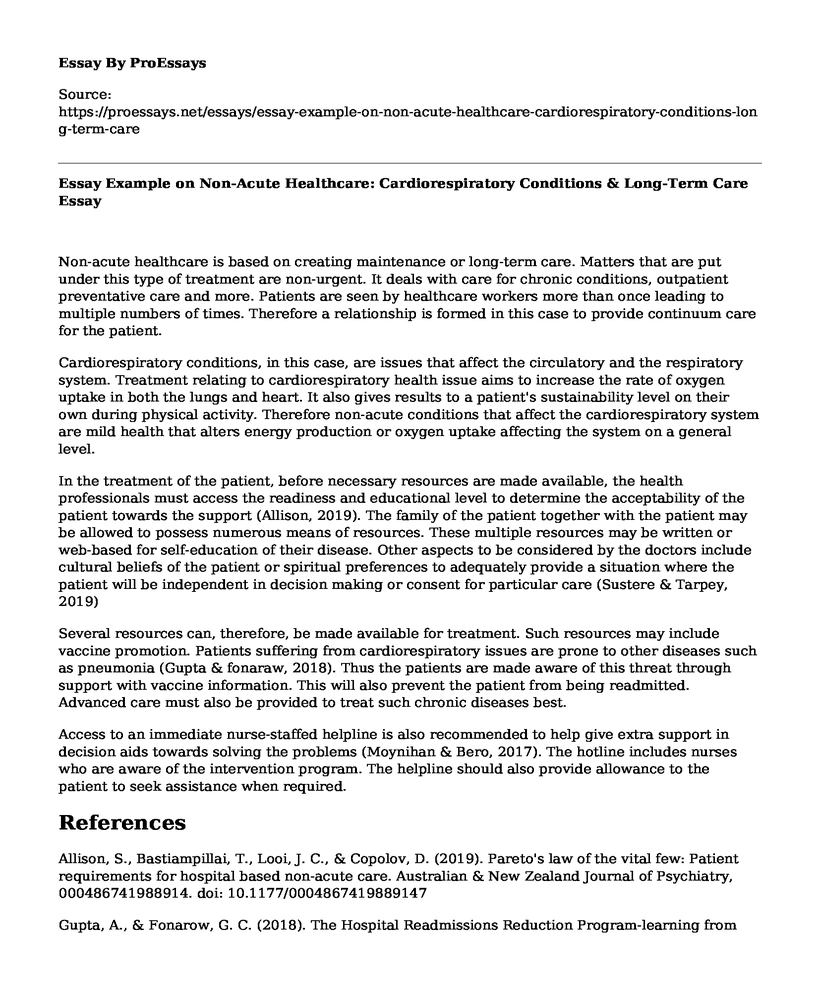Non-acute healthcare is based on creating maintenance or long-term care. Matters that are put under this type of treatment are non-urgent. It deals with care for chronic conditions, outpatient preventative care and more. Patients are seen by healthcare workers more than once leading to multiple numbers of times. Therefore a relationship is formed in this case to provide continuum care for the patient.
Cardiorespiratory conditions, in this case, are issues that affect the circulatory and the respiratory system. Treatment relating to cardiorespiratory health issue aims to increase the rate of oxygen uptake in both the lungs and heart. It also gives results to a patient's sustainability level on their own during physical activity. Therefore non-acute conditions that affect the cardiorespiratory system are mild health that alters energy production or oxygen uptake affecting the system on a general level.
In the treatment of the patient, before necessary resources are made available, the health professionals must access the readiness and educational level to determine the acceptability of the patient towards the support (Allison, 2019). The family of the patient together with the patient may be allowed to possess numerous means of resources. These multiple resources may be written or web-based for self-education of their disease. Other aspects to be considered by the doctors include cultural beliefs of the patient or spiritual preferences to adequately provide a situation where the patient will be independent in decision making or consent for particular care (Sustere & Tarpey, 2019)
Several resources can, therefore, be made available for treatment. Such resources may include vaccine promotion. Patients suffering from cardiorespiratory issues are prone to other diseases such as pneumonia (Gupta & fonaraw, 2018). Thus the patients are made aware of this threat through support with vaccine information. This will also prevent the patient from being readmitted. Advanced care must also be provided to treat such chronic diseases best.
Access to an immediate nurse-staffed helpline is also recommended to help give extra support in decision aids towards solving the problems (Moynihan & Bero, 2017). The hotline includes nurses who are aware of the intervention program. The helpline should also provide allowance to the patient to seek assistance when required.
References
Allison, S., Bastiampillai, T., Looi, J. C., & Copolov, D. (2019). Pareto's law of the vital few: Patient requirements for hospital based non-acute care. Australian & New Zealand Journal of Psychiatry, 000486741988914. doi: 10.1177/0004867419889147
Gupta, A., & Fonarow, G. C. (2018). The Hospital Readmissions Reduction Program-learning from failure of a healthcare policy. European Journal of Heart Failure, 20(8), 1169-1174. doi: 10.1002/ejhf.1212
Moynihan, R., & Bero, L. (2017). Toward a Healthier Patient Voice. JAMA Internal Medicine, 177(3), 350. doi: 10.1001/jamainternmed.2016.9179
Sustere, E., & Tarpey, E. (2019). Least restrictive practice: its role in patient independence and recovery. The Journal of Forensic Psychiatry & Psychology, 30(4), 614-629. doi: 10.1080/14789949.2019.1566489
Cite this page
Essay Example on Non-Acute Healthcare: Cardiorespiratory Conditions & Long-Term Care. (2023, Mar 26). Retrieved from https://proessays.net/essays/essay-example-on-non-acute-healthcare-cardiorespiratory-conditions-long-term-care
If you are the original author of this essay and no longer wish to have it published on the ProEssays website, please click below to request its removal:
- Essay Sample on Material and Methods of Dentistry
- Business Plan for Golden Hearts Senior Care
- Probiotics Paper Example
- Essay Sample on Greek Health Beliefs
- Essay Sample on Youth Smoking Trends: E-Cigs vs Traditional Cigs
- Essay Example on Cross-Cultural Challenges for Social Workers: Navigating Language & Meaning
- Paper Example on Analyzing Transmission Risks: Healthcare Workers and Portable Medical Equipment







